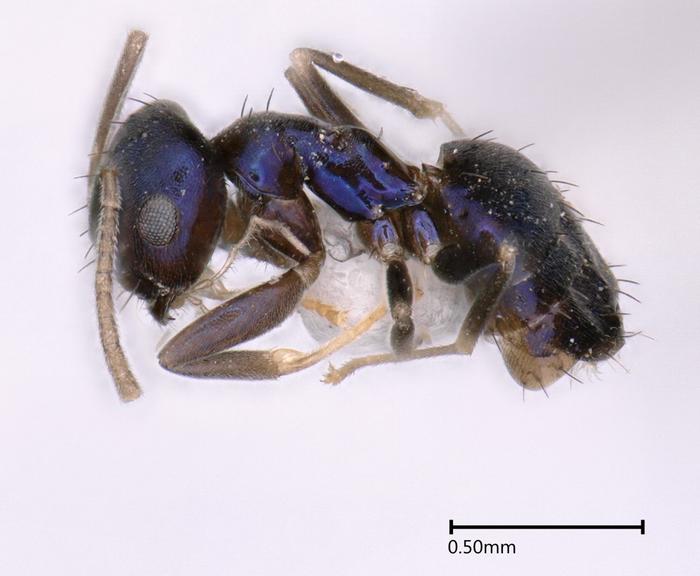Nothing like the common red, black, or brown ants, a stunning blue ant has been discovered from Yingku village in Arunachal Pradesh, northeastern India. This new species belongs to the rare genus Paraparatrechina and has been named Paraparatrechina neela. The word “neela” signifies the color blue in most Indian languages – a fitting tribute to the ant’s unique coloration.

Credit: Sahanashree R
Nothing like the common red, black, or brown ants, a stunning blue ant has been discovered from Yingku village in Arunachal Pradesh, northeastern India. This new species belongs to the rare genus Paraparatrechina and has been named Paraparatrechina neela. The word “neela” signifies the color blue in most Indian languages – a fitting tribute to the ant’s unique coloration.
Entomologists Dr. Priyadarsanan Dharma Rajan and Sahanashree R, from Ashoka Trust for Research in Ecology and the Environment (ATREE) in Bengaluru, along with Aswaj Punnath from the University of Florida, collaborated to describe the remarkable new species. Their scientific description of the ant is published in the open-access journal ZooKeys.
“While exploring a tree hole about 10 feet up in a steep cattle track in the remote Yinku village one evening, something sparkled in the twilight. With the dim light available, two insects were sucked into an aspirator. To our surprise, we later found they were ants” said the researchers.
The ant was found during an expedition to Siang valley in Arunachal Pradesh to resurvey its biodiversity after the century-old ‘Abhor expedition’. The original Abor expedition from the period of colonial rule in India was a punitive military expedition against the indigenous people there in 1911-1912. A scientific team also accompanied the military expedition, to document the natural history and geography of the Siang Valley. Тhis expedition encountered several challenges, including hostile terrain, difficult weather conditions, and resistance from local tribes. Despite the challenges, it managed to explore and map large parts of the Siang Valley region, cataloguing every plant, frog, lizard, fish, bird & mammal and insects they found, with the discoveries published in several volumes from 1912 to 1922 in the Records of the Indian Museum.
Now, a century later, a team of researchers from ATREE and a documentation team from Felis Creations Bangalore have embarked on a series of expeditions under the banner “Siang Expedition”, to resurvey and document the biodiversity of the region. This expedition was funded by the National Geographic Society through the wildlife-conservation expedition grant.
“Nestled within a Himalayan biodiversity hotspot, Arunachal Pradesh’s Siang Valley presents a world of unparalleled diversity, much of it yet to be explored. However, this very richness, both cultural and ecological, faces unprecedented threats. Large-scale infrastructure projects like dams, highways, and military installations, along with climate change, are rapidly altering the valley. The impact extends beyond the valley itself, as these mountains play a critical role not only in sustaining their own diverse ecosystems but also in ensuring the well-being of millions of people living downstream”, said Priyadarsanan Dharma Rajan, corresponding author of the paper.
Paraparatrechina neela is a small ant with a total length of less than 2mm. Its body is predominantly metallic blue, except for the antennae, mandibles, and legs. The head is subtriangular with large eyes, and has a triangular mouthpart (mandible) featuring five teeth. This species has a distinct metallic blue colour that is different from any other species in its genus.
Blue is relatively rare in the animal kingdom. Various groups of vertebrates, including fish, frogs, and birds, as well as invertebrates such as spiders and flies and wasps, showcase blue coloration. In insects, it is often produced by the arrangement of biological photonic nanostructures, which create structural colours rather than being caused by pigments. While blue coloration is commonly observed in some insects like butterflies, beetles, bees, and wasps, it is relatively rare in ants. Out of the 16,724 known species and subspecies of ants worldwide, only a few exhibit blue coloration or iridescence.
The discovery of Paraparatrechina neela contributes to the richness of ant diversity and represents the unique biodiversity of the Eastern Himalayas, and its blue coloration raises intriguing questions. Does it help in communication, camouflage, or other ecological interactions? Delving into the evolution of this conspicuous coloration and its connections to elevation and the biology of Paraparatrechina neela presents an exciting avenue for research.
Original source:
Sahanashree R, Punnath A, Rajan Priyadarsanan D (2024) A remarkable new species of Paraparatrechina Donisthorpe (1947) (Hymenoptera, Formicidae, Formicinae) from the Eastern Himalayas, India. ZooKeys 1203: 159-172. https://doi.org/10.3897/zookeys.1203.114168
Journal
ZooKeys
DOI
10.3897/zookeys.1203.114168
Article Title
A remarkable new species of Paraparatrechina Donisthorpe (1947) (Hymenoptera, Formicidae, Formicinae) from the Eastern Himalayas, India
Article Publication Date
30-May-2024




